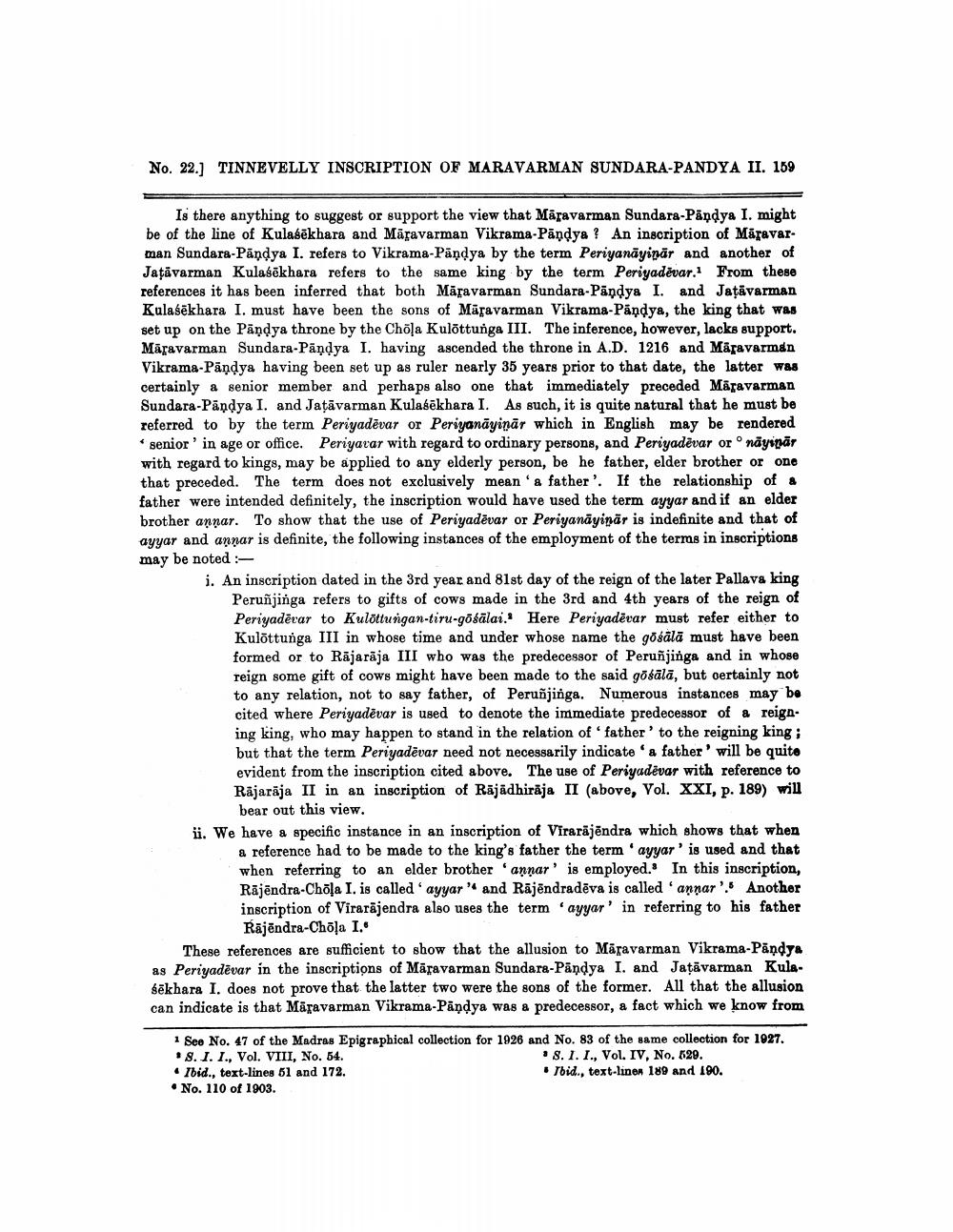________________
No. 22.] TINNEVELLY INSCRIPTION OF MARAVARMAN SUNDARA-PANDYA II. 159
Is there anything to suggest or support the view that Maravarman Sundara-Pandya I. might be of the line of Kulasekhara and Maravarman Vikrama-Pandya? An inscription of Māravarman Sundara-Pandya I. refers to Vikrama-Pandya by the term Periyanayiņār and another of Jaṭavarman Kulasekhara refers to the same king by the term Periyadevar. From these references it has been inferred that both Maravarman Sundara-Pandya I. and Jaṭāvarman Kulasekhara I. must have been the sons of Maravarman Vikrama-Pandya, the king that was set up on the Pandya throne by the Chōla Kulōttunga III. The inference, however, lacks support. Maravarman Sundara-Pandya I. having ascended the throne in A.D. 1216 and Māravarman Vikrama-Pandya having been set up as ruler nearly 35 years prior to that date, the latter was certainly a senior member and perhaps also one that immediately preceded Maravarman Sundara-Pandya I. and Jaṭāvarman Kulasekhara I. As such, it is quite natural that he must be referred to by the term Periyadevar or Periyanayiṇār which in English may be rendered * senior' in age or office. Periyavar with regard to ordinary persons, and Periyadevar or ° nāyinār with regard to kings, may be applied to any elderly person, be he father, elder brother or one that preceded. The term does not exclusively mean a father'. If the relationship of a father were intended definitely, the inscription would have used the term ayyar and if an elder brother annar. To show that the use of Periyadevar or Periyanayinär is indefinite and that of ayyar and annar is definite, the following instances of the employment of the terms in inscriptions may be noted:
i. An inscription dated in the 3rd year and 81st day of the reign of the later Pallava king Peruñjinga refers to gifts of cows made in the 3rd and 4th years of the reign of Periyadevar to Kulottungan-tiru-gōsalai. Here Periyadevar must refer either to Kulottunga III in whose time and under whose name the gōśālā must have been formed or to Rajaraja III who was the predecessor of Peruñjinga and in whose reign some gift of cows might have been made to the said göśālā, but certainly not to any relation, not to say father, of Peruñjinga. Numerous instances may be cited where Periyadevar is used to denote the immediate predecessor of a reigning king, who may happen to stand in the relation of father' to the reigning king; but that the term Periyadevar need not necessarily indicate a father' will be quite evident from the inscription cited above. The use of Periyadevar with reference to Rajaraja II in an inscription of Rajadhiraja II (above, Vol. XXI, p. 189) will bear out this view.
ii. We have a specific instance in an inscription of Virarajendra which shows that when
a reference had to be made to the king's father the term 'ayyar' is used and that when referring to an elder brother annar is employed. In this inscription, Rajendra-Chōla I. is called ayyar" and Rajendradeva is called 'annar's Another inscription of Virarajendra also uses the term ayyar' in referring to his father Rajendra-Chola I.
"
These references are sufficient to show that the allusion to Maravarman Vikrama-Pandya as Periyadevar in the inscriptions of Maravarman Sundara-Pandya I. and Jaṭavarman Kulasekhara I. does not prove that the latter two were the sons of the former. All that the allusion can indicate is that Maravarman Vikrama-Pandya was a predecessor, a fact which we know from
1 See No. 47 of the Madras Epigraphical collection for 1926 and No. 83 of the same collection for 1927. 8. I. I., Vol. VIII, No. 54. 8. I. I., Vol. IV, No. 529. Ibid., text-lines 51 and 172. Ibid., text-lines 189 and 190. No. 110 of 1903.




